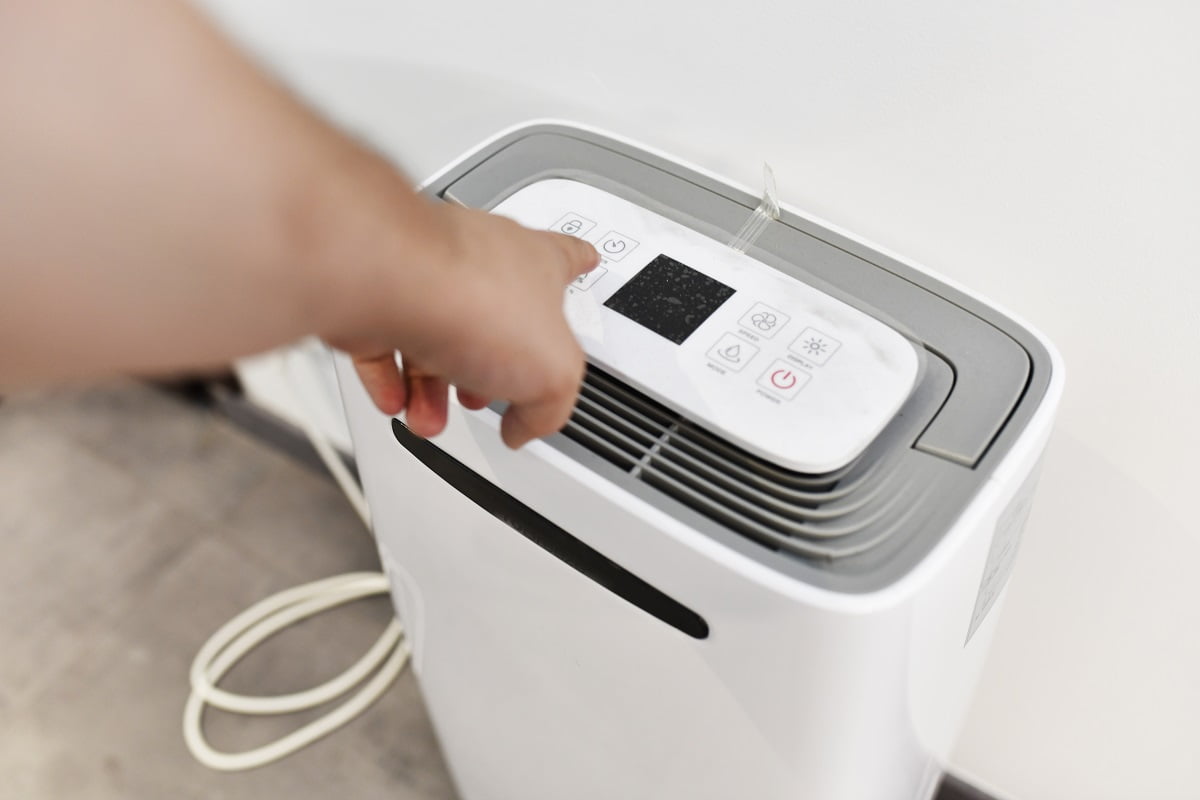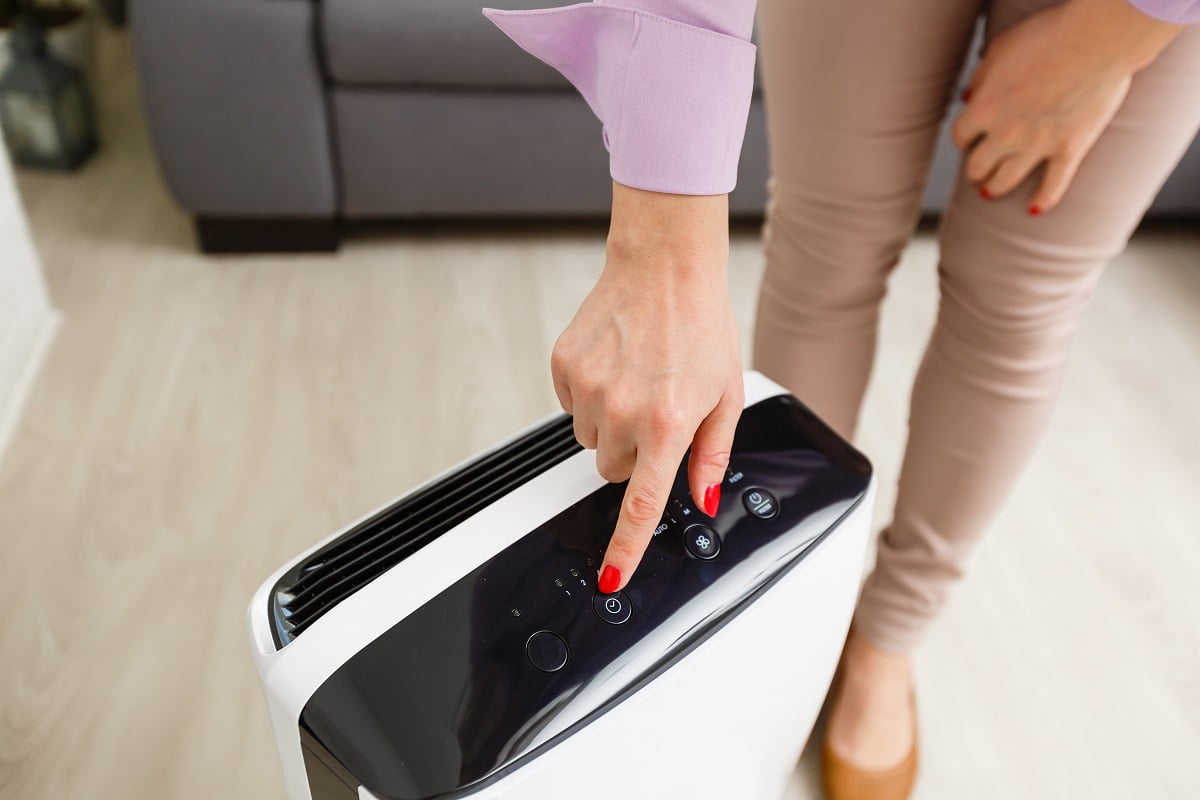Humidity is an unfortunate by-product of the lovely rains, which can be mitigated by getting a dehumidifier for your bedroom.

A dehumidifier can help reduce the humidity level of a room, but there is one small catch to them: figuring out the right setting. Since these appliances come in many models and sizes, picking out one that suits your room and residential temperature becomes vital to their success.
So, what should the ideal temperature setting be for your bedroom? The ideal setting should be between 70 and 90 degrees F for residential refrigerant dehumidifiers. But there are other factors that need to be looked into - which is why we have curated this guide.
Relative Humidity
The term ‘relative humidity’ refers to the amount of moisture present in the atmosphere in relation to what would be present in saturated air. If the temperature is high, the amount of moisture the air can hold is also high, and vice versa.
Every part of your home will have a different relative humidity depending on where they are situated. If you live close to a forest or a beach, you’ll experience a higher level of humidity, making a dehumidifier all but necessary.
The relative humidity level will contribute to your decision of getting a dehumidifier, if it hasn’t already.
How Does A Dehumidifier Work

To put it simply, a home dehumidifier reduces the relative humidity of the air by either refrigeration or absorption/adsorption. The two methods are equally effective in stopping the rise of humidity levels in your home.
1. Refrigeration
Most dehumidifiers use refrigeration as their primary way of reducing the relative humidity in your home by letting in warm air through a fan in the device. The warm, moist air passes over pipes containing coolants, condensing the moisture in the air, after which the air is allowed back into the room. This improves the air quality in addition to lowering the moisture levels of the room.
2. Absorption/Adsorption
Some dehumidifiers reduce the moisture levels of the room by absorbing the water content out of the air. It involves drawing in air through a duct, which is then passed through a rotating wheel that absorbs the moisture. Dry air is then allowed back into the room.
The way absorption and adsorption differ is that absorption involves water soaking into a material, while adsorption has the moisture content picked up on the surface of the material.
Utilizing Dehumidifiers
If your house feels very humid during the summer, you can put a dehumidifier to good use and trap the moisture in the air. There is no clear-cut temperature value you can set on your dehumidifier to keep the humidity perfectly at bay. However, you can use it to keep the moisture in the air low enough to ensure an optimal comfort level.
The objective of using a dehumidifier is to increase your comfort and remove issues born of humidity, such as pests, odors, and mold.
1. Sizing Your Dehumidifier
There is no such thing as a dehumidifier that is perfect for every room. Dehumidifiers come in all kinds of shapes and sizes, catering to the kind of space they’ll be used in.
Too small and your dehumidifier will not be effective at all. Too large, and you may end up drying out your skin and hair because of the excess drying agents. Not to mention you’ll end up wasting your money and space on something that can be achieved with a smaller device.
For reference, a dehumidifier as large as a smoke alarm is fine for a bathroom, but too small for a bedroom.
2. Placing The Dehumidifier
The right location to keep your dehumidifier is in the middle of the bedroom. This will allow the device to reduce humidity levels much more efficiently than when placed in the corner.
Close your doors to maximize the dehumidification and cool the room down to save your device from excess load. It’s also a good idea to have an air conditioning unit working in your bedroom with the dehumidifier to distribute the energy expenditure.
3. Maximizing The Efficiency
Remember to turn the device off after a while, as the aforementioned drying agents may have an unintended consequence. It’s important to utilize your dehumidifier in moderation and run it alongside your air conditioner.
4. Maintenance
You’ll need to remove the moisture reserves of the appliance once in a while. Once a month would suffice, if you use your dehumidifier regularly.
Some dehumidifiers will signal you to empty the reserves once full, as they’ll turn off automatically if you don’t.
Ideal Settings For Bedroom Dehumidifiers
Dehumidifier settings vary based on a number of factors, such as the room temperature, humidity levels, and size of the room. Let’s explore these settings in detail.
1. Temperatures
Differences in room temperature will require the dehumidifier to work harder in order to maintain cooler air and a comfortable level in the room. This is because the inside of the condenser will have to be cooler than the surrounding atmosphere to properly condense the humidity. Meaning, if the temperature drops, your dehumidifier will struggle to keep the room temperature low.
Residential dehumidifiers ideally work in the range of 70 to 90 degrees Fahrenheit. Other kinds of dehumidifiers, for example Low Grain Refrigerant or Desiccant dehumidifiers, work more efficiently in different temperature ranges.
2. Humidity Level
You can perform a simple test for humidity levels to know if you should turn the dehumidifier on. If it is excessively high, using your dehumidifier is a no-brainer. You can keep the device on 30-50%, which is considered by most to be the right humidity level.
Test The Humidity Level Of Your Bedroom
To find out the relative humidity of your room, you can perform the ice cube test. While this will not give you the exact figures of the moisture content of your bedroom’s air, it will give you a general idea.
Simply put a few cubes of ice into a glass of water, stir, and wait for a few minutes. If there is no moisture on the outer side of the glass, your room has dry air, which may mean you need a humidifier.
In case the condensation on the outer side of the glass is high, the air has high moisture content and will require you to use your dehumidifier.
Safety Precautions
The combination of water and electricity is quite the safety hazard, which is why you should read the safety guidelines of your dehumidifier before operating it. You can follow these precautions in addition to the manufacturer’s guide to minimize any risks of dehumidifier-related accidents:
- Always plug the device in a three pin socket
- Remove dust build-up from the dehumidifier
- Wash air filters regularly
- Check drainage passages for debris
- Keep the appliance away from the walls, furniture, and curtains
- Turn it off when not in use
- Be vigilant for any burning smell or unusual noises
Health Benefits Of Using A Dehumidifier
The benefits of a dehumidifier in the bedroom extend beyond making your afternoons more comfortable, even though they do make the humidity pretty tolerable. They have tangible health and hygienic benefits that can significantly improve your quality of life. Not to mention the elimination of musty smells.
Excess moisture carries with it bacteria and microorganisms that may enter your body when you breathe in. Not only that, but pests like dust mites and cockroaches also thrive in areas with moist air, which are hygienic hazards that must be terminated quickly. You will even see a rise in mold growth in a damp environment.
Dehumidifiers eliminate the very source of the problem by reducing high humidity levels and keeping the temperature low. With dust mites and mold growth in check, you’ll also have lowered chances of an allergic reaction or asthma.
What Temperature Should I Set My Dehumidifier In Bedroom FAQs ?
How long should I run a dehumidifier in my bedroom?
You can safely run a dehumidifier for around 12 hours every day for maximum reduction of your bedroom’s humidity level. This will keep your room feeling fresh for far longer than otherwise.
But, it isn’t a good idea to keep it running 24x7, as it will cause the dry air to have an effect on your skin and hair.
How much energy do dehumidifiers consume?
Dehumidifiers remain turned on for a long time, resulting in their relatively low wattage and hourly electrical usage racking up.
Some dehumidifiers can consume up to 23 kWH of electricity per day, making their electrical consumption a substantial hit on the wallet.
How does a dehumidifier prevent mold growth?
Mold thrives in the presence of warm air and moisture, and the fungi will spread as long as they are in a moist environment. While dehumidifiers don’t kill mold directly, they stop their primary method of transmission and reproduction, thus stopping them from ever taking root.
Should I keep the windows open while using a dehumidifier?
No, you should keep the windows closed while your dehumidifier is running. Open windows invite more moisture, meaning more work for your dehumidifier. Not only does it increase the electrical consumption, but it also keeps the humidity levels from dropping.

What Temperature Should I Set My Dehumidifier In Bedroom Conclusion
By keeping the room temperature and bedroom size in mind, you’ll be able to maximize the reduction of indoor relative humidity in your bedroom. If you live in a tropical climate and are on the fence about purchasing a dehumidifier, think of all the sweat and discomfort that high humidity brings.
Scrutinize in great detail the most efficient brand of dehumidifiers for the bedroom and consider looking into the device. Not only will it reduce the humidity level of the room, the indoor air quality will also increase.
The benefits of a dehumidifier are plenty, and with the best setting, you’ll eliminate discomfort before long.
